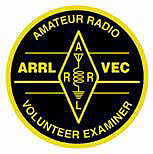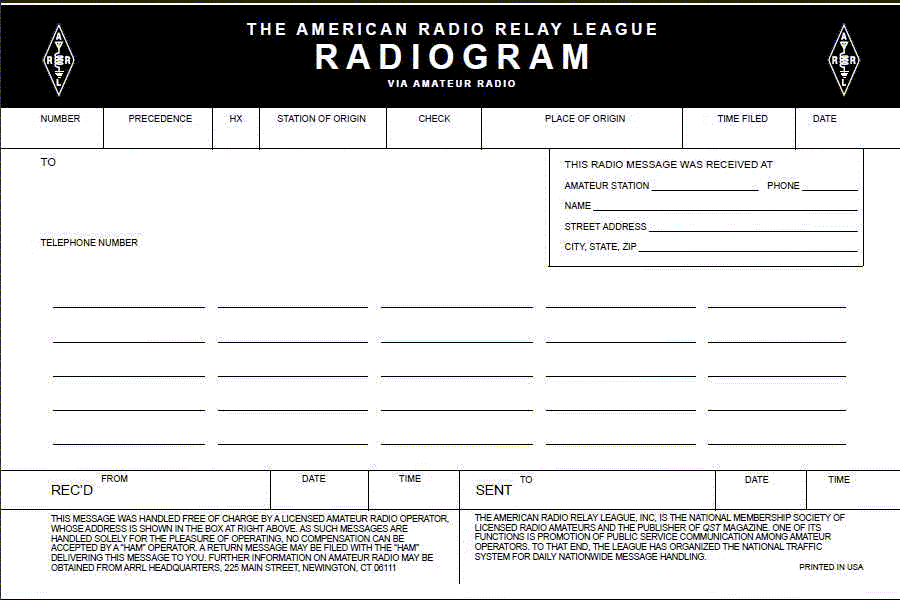ARRL Radiograms, like the FEMA forms ICS-213, used to communicate formal traffic. ICS-213 will be covered elsewhere. This document focuses on the “Radiogram” format, used heavily in ARES exercises and actual emergencies.
The Radiogram has 4 parts: Preamble, Address, Text, and Signature. The “Records” block constitutes a possible 5th block, often not counted as part of the radiogram since it is there for station record-keeping purposes and is not communicated to other stations.
PREAMBLE
The preamble is message tracking information. It ensures a way to track a message from where it originates to the destination. The preamble is filled in by the first amateur radio operator to transmit the message (the originator). Here are the various components of the preamble:
1) NR: The Message Number. Any station that will be originating traffic will assign a message number to each outgoing message he or she originates. It should be sequentially numbered.
2) PREC: Message Precedence. Values can be EMERGENCY (spelled out), R for routine, W for welfare, P for priority. NOTE: During an exercise the precedence should be preceded by the word “TEST” or “EXERCISE” (TEST is preferred).
3) HX: Handling Instructions. HXA### Is used to specify phone delivery, collect call allowed by addressee within ### miles. HXB## indicates how many hours can pass before message delivery is aborted. HXC indicates the originator wishes to know the date and time the message was delivered. HXD indicates identity of receiving or relaying station as well as date and time message was passed is requested. HXE indicates a response message from addressee is requested. HXF###### indicates delivery is held until the provided date (######). HXG Delivery by mail or landline toll is not required. If there is a cost involved in delivery then cancel message and send service message back to sender.
4) STN-ORIG: Originating Station. This is the station that created the initial message. Remember, the preamble should not be changed.
5) CK:: Check is the number of word “groups”. This verifies the correct number of groups have been copied. Each punctuation (use of which should be avoided) is counted as a word group. X can be used as a period, other punctuation is spelled out.
6) Place-Of-Orig: The city and state of origin. Do not use punctuation.
7) Time Filed: This is optional. Time is given in 24 hour format followed by Z for UTC “Zulu”, L for Local, or a time zone. Example: 1245Z Oct 1.
8) MON / DAY: Month and day of message. If (7) is provided the date better match!
|
Preamble Address
Message Text ------------ Signature Records |
|
ADDRESS
1) ADDRESSEE: The name of the recipient. If message is to children or to be handled by a third party in the home an additional line with C/O and the name of the person named to receive on behalf of the addressee.
2) STREET ADDRESS: Can be multi-line as well if needed. The first line may contain an institution name (nursing home, hospital, etc). The actual address should be provided in typical postal format.
3) CITY, STATE ZIP: Standard postal delivery format should be used. The state should be a standard two-character abbreviation.
4) TELEPHONE NUMBER: Provided as three groups of numbers, no dashes or dots.
5) OP NOTE: This is a note for the message handlers and may provide direction for delivery. For instance, delivery during business hours, weekend, etc.
MESSAGE TEXT
The text area is the actual message to be communicated. The section has up to 25 words. Punctuation should be avoided and should be spelled as a word group, and count as such. A period may be replaced with an “X”. Numbers with decimals should replace the decimal with an “R”. Q codes are allowed as well. Greetings and endings should be included in the text.
SIGNATURE
One line identifying the person requesting the message be sent (not the originating operator, but the person being served). Sample: BRIAN KI4LZG AT TEMPLE GA. Some radiogram forms have a separate “Signature” section, but the signature is often simply the last line of the message text.
SIGNATURE OP NOTE
Gives special instructions for the last operator in the line before the message is delivered. This is not a field, but put in the last line of the radiogram, beginning with OP NOTE and followed by the special instructions.
RECORDS BLOCK
1) RCVD FROM: The station the copying station received the message from.
2) NET: The net the message was copied on.
3) DATE/TIME: Date & Time you copied the message.
4) SENT TO: If you are not the last station before delivery then you’ll log who you handed the message off to, the net that was done on, and the DATE/TIME you relayed the message.





